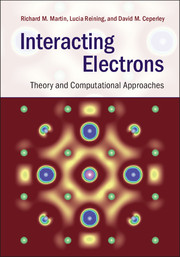Book contents
- Frontmatter
- Dedication
- Contents
- Preface
- Acknowledgments
- Notation
- Part I Interacting electrons: beyond the independent-particle picture
- Part II Foundations of theory for many-body systems
- Part III Many-body Green's function methods
- 9 Many-body perturbation theory: expansion in the interaction
- 10 Many-body perturbation theory via functional derivatives
- 11 The RPA and the GW approximation for the self-energy
- 12 GWA calculations in practice
- 13 GWA calculations: illustrative results
- 14 RPA and beyond: the Bethe–Salpeter equation
- 15 Beyond the GW approximation
- 16 Dynamical mean-field theory
- 17 Beyond the single-site approximation in DMFT
- 18 Solvers for embedded systems
- 19 Characteristic hamiltonians for solids with d and f states
- 20 Examples of calculations for solids with d and f states
- 21 Combining Green's functions approaches: an outlook
- Part IV Stochastic methods
- Part V Appendices
- References
- Index
19 - Characteristic hamiltonians for solids with d and f states
from Part III - Many-body Green's function methods
Published online by Cambridge University Press: 05 June 2016
- Frontmatter
- Dedication
- Contents
- Preface
- Acknowledgments
- Notation
- Part I Interacting electrons: beyond the independent-particle picture
- Part II Foundations of theory for many-body systems
- Part III Many-body Green's function methods
- 9 Many-body perturbation theory: expansion in the interaction
- 10 Many-body perturbation theory via functional derivatives
- 11 The RPA and the GW approximation for the self-energy
- 12 GWA calculations in practice
- 13 GWA calculations: illustrative results
- 14 RPA and beyond: the Bethe–Salpeter equation
- 15 Beyond the GW approximation
- 16 Dynamical mean-field theory
- 17 Beyond the single-site approximation in DMFT
- 18 Solvers for embedded systems
- 19 Characteristic hamiltonians for solids with d and f states
- 20 Examples of calculations for solids with d and f states
- 21 Combining Green's functions approaches: an outlook
- Part IV Stochastic methods
- Part V Appendices
- References
- Index
Summary
Summary
In the previous chapters DMFT has been developed as a methodology for calculation of dynamical and thermodynamic properties of many-body systems, with applications to model systems. In order for DMFT to be a general method for quantitative calculations, there must be systematic procedures to derive all the ingredients from first principles. In this chapter we consider the most prominent examples, materials with partially filled 3d, 4f, or 5f localized, atomic-like states, and set up the characteristic form of the hamiltonian. This is the basis for DFT+DMFT methods discussed here and used in the examples in Ch. 20, and for the combination of DMFT with many-body perturbation theory in Ch. 21. Simpler techniques, including self-interaction correction, DFT+U, and DFT+Gutzwiller, are also useful and are summarized in the last sections of this chapter.
Up to this point, dynamical mean-field theory has been developed for model systems with Hubbard-type hamiltonians, where the hopping matrix elements and interactions are considered as parameters. For problems with strong interactions, DMFT leads to renormalized bands, satellites in the one-particle spectra, magnetic phase transitions and local moments, metal–insulator transitions, and many other phenomena observed in real materials, as brought out in Ch. 2. The purpose of this chapter is to provide the framework for a quantitative theory of these materials.
These are difficult problems, experimentally, theoretically, and computationally, and the first step is to identify the aspects of the materials that must be treated explicitly as the local strongly interacting system, and the “rest” that are treated by a different method. This division of the problem is useful because a real material involves many degrees of freedom, i.e., the electronic states must be described in a basis sufficiently large to describe all the relevant states. However, the part that can be treated by non-perturbative solvers (Ch. 18) is limited by the computational cost that scales rapidly with the number of states included in the embedded site or cluster. Thus one must choose a small number of localized orbitals that inevitably are non-unique. This may seem like a step backward for quantitative methods; however, it opens a window for methods to treat these interesting problems and it presents a challenge to overcome the limitations.
- Type
- Chapter
- Information
- Interacting ElectronsTheory and Computational Approaches, pp. 502 - 526Publisher: Cambridge University PressPrint publication year: 2016



